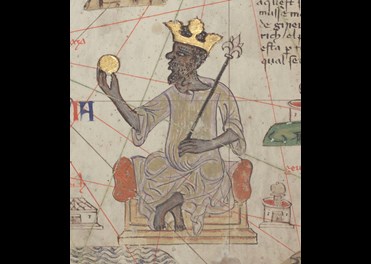By Ernest Chi Fru
The geologists, miners, and geochemists of ancient West African merchant empires
Mansa Musa, the celebrated Sultan of the 14th century West African merchant empire of Mali (Figure 1), ruled for 25 years, from 1312 to 1337 AD. His prosperous and philanthropic reign has puzzled historians to this day, with word out that he is perhaps the richest man who ever lived (Green, 2019).
Mansa Musa commissioned and built the ancient University of Timbuktu, one of the world’s oldest Universities, transforming the city of Timbuktu into a world class educational centre that pulled scholars from across North Africa, Andalusia, and Arabia.
Little was however known of Mansa Musa in the wider world until his epic pilgrimage to Mecca via Cairo in 1324 AD made him a household name across the Mediterranean region and Arabia (Green, 2019).
Recorded history has it that Mansa Musa entered Cairo with a caravan of 60,000 soldiers on ornate horses, dressed in brocade silk outfits. He came with a supply of gold never seen before in the possession of a single individual. Five hundred slaves, each carrying a 2 kg gold wand, heralded Mansa Musa’s arrival (Green, 2019).
It is said that Mansa Musa’s generosity flowed as much as his wealth and that his lavish gifting of gold to the deprived left a 10-year inflation in his trail. Thirty-eight years after his death, this reputation was depicted on the Catalan Atlas of 1375 by a gold crowned black king brandishing a gold coin in one hand and a gold staff in another (Figure 2).
For many centuries before Mansa Musa’s exploits, West African miners supplied gold through exotic Saharan trade routes to the expansionist economies of the Mediterranean and Arabia. But it was Mansa Musa’s astonishing revelation of the magnitude of Africa’s gold wealth that brought the Portuguese calling on the West Africa shores in the 15th century. The Portuguese soon started the Trans-Atlantic Slave trade, rounded the Cape of Good Hope, and never looked back.
The growth in demand for Mali’s gold, expanded production in the Gold Coast Forest, pioneered by the indigenous technologies of the Akan people in present day Ivory Coast and Ghana (Green, 2019). The existing technologies allowed mining shafts and tunnels to penetrate the earth down to at least 70 m. By the 1480s, the forest gold mines along the Volta River alone supplied an estimated one tonne of gold per year to the Portuguese merchants (Green, 2019). Portugal’s monopoly on the West African gold trade in the 1490s produced the Italian moniker, The King of Gold, for King John II of Portugal, the man who invigorated Portugal’s battered economy and intensified the exploration of Africa and Asia.
When asked on his stopover in Cairo, Mansa Musa told Judge Fakhr al-Din that his gold came from the part of his empire inhabited by pagans. The judge wondered why he didn’t simply conquer and take over the gold mining operation. Mansa Musa said they did before but could not find gold.
This narrative suggests that the ability to prospect and mine gold economically was a specialist skill. A skill reserved to a group of people who had excellent knowledge of the local geology and expert abilities to identify profitable gold fields and deposits. Mansa Musa said his supply came in different sizes, some shaped like rings, some like carob seeds and so on, collected as a binding tribute to him (Green, 2019).
A written report in the 1520s by the Berber Andalusian diplomat and geographer, Hassan Quazzan, later captured, moved to Rome, and renamed Johannes Leo Africanus, narrates an eyewitness account of black Africans bringing gold to purchase European and North African goods at the marketplace in Gao. He explains in his popular book at the time, Description of Africa, how the Africans brought so much gold to the market, they ended up returning to their countries with as much as half of it because there were not enough purchasable goods to match the value of their gold (Green, 2019).
A few hundred years later, the descendants of these ancient African miners, gold merchants, geologists, and geochemists led the first European explorers to Africa’s mineral reserves. Yet no adequate account of this can be found or acknowledged in the scientific literature.
Mansa Musa’s legendary account may be dismissed as a historical sensibility of no scientific relevance, as has been with most of Africa’s uncelebrated past and prolific civilisations. An attitude propagated by the unsustainable telling of history from the one-sided perspective of the western historian.
The idea of describing the prospectors and miners of Mansa Musa’s gold as geologists and geochemists is delicate. It is perplexing why this should be the case, considering the size of the industrial scale mining activity these clever people built to see the emergence of the powerful, rich West African empires of Ghana, Mali, and Songhay (also spelled Songhai). Their empires fuelled human and economic growth across Africa, the Mediterranean region and Arabia. Yet this might and influence conjure a sense of incredulity immediately rejected by those who desire the alternate account of a lost people.
This rejection arises because popular western culture, supported by phoney 19th century scientific claims, had long cancelled the idea of the existence of a valid, complex African culture and civilisation governed by laws, science, and economic intelligence. The impact of these unjust acts has been so perverse in the modern psyche that it is unsurprising to meet contemporary educated Africans who have never heard of the great Mansa Musa. You may be surprised as a non-African, but surely you will think that every school child in Africa would be clued in on the immense influence of the powerful West African empires Mansa Musa helped build. To many, their ancestors are an imagination, something to be perpetually embarrassed of and therefore disconnect from by assuming borrowed identities from elsewhere.
These negative stereotypes and habits persist primarily because education in many African countries continue to maintain the deliberate colonial mission of producing clerks to serve colonial projects. Even with some improvements, taught curricula glaringly lack a grounding on an African identity. The outcome has been to produce individuals to serve rather than creatively solve complex problems plaguing their communities. The creative, independent, and self-promoting people of Mansa Musa’s time have been replaced with the dependent and self-loathing subjects of modern times.
Yet the aspirations and ambitions of Mansa Musa’s geologists and miners, with their unique tools and methods, were no different from those of the geologists and ragtag miners who scurried down the precarious tin and copper mines on the coast of Cornwall many centuries ago. It is this historical recognition of bravery and ingenuity among Cornish copper and tin miners that made the hit TV series Poldark a success. It put the narrative of metal extraction in a positive spotlight despite the tragedies that accompanied it, and certainly distilled in Cornish people confidence in their capabilities. It stoked a proud sense of the past as a source of place, belonging, and identity.
In the same light, the desire for a diverse, equitable, and inclusive geoscience community will only reach a wider and more accommodating audience when minoritised people begin to identify themselves and their stories in the development of the disciplines.
Decolonisation of the curriculum is central to achieving this goal. Curriculum decolonisation is not about recounting or recognising a country’s colonial history, it is about designing engaging curricula that tell the stories of scientific and economic achievements of all people.
The history of gold mining in West Africa, one of many cultural, scientific, and economic wonders of the ancient African continent, doesn’t only demonstrate the rise and fall of magnificent ancient African merchant empires and civilisations. It highlights and places Africa’s history within the context of technological development, the ambition of people, nation building, economic empowerment, civil society, aristocracy, diplomacy, integrity, and ingenuity, as demonstrated by the influence Mansa Musa’s gold empire had on far flung places like the Mediterranean corridor and the middle East.
References
Green, T. (2019). A fistful of shells. West Africa from the rise of the slave trade to the age of revolution. Penguin Books.
AUTHOR: Ernest Chi Fru
Ernest was born in Cameroon, and is currently a Senior Lecturer at the School of Earth and Environmental Sciences, Cardiff University, UK. He obtained a PhD in Geomicrobiology from Gothenburg University, Sweden. Ernest was a Marie Curie fellow and a recipient of an ERC starting grant from the European Research Council. Studying and working in 8 academic institutions spread across Africa, Europe and North America, has exposed Ernest to diverse cultures and societies.







